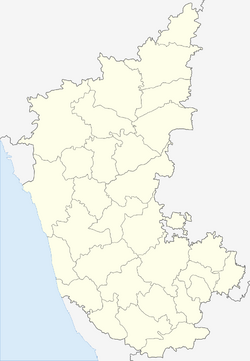| ||||||||||||||
| Shimoga district | |
|---|---|
| — district — | |
| Jog Falls in full flow during the monsoon season. | |
| Coordinates: Coordinates: | |
| Country | |
| State | Karnataka |
| Headquarters | Shimoga |
| Talukas | Bhadravathi, Hosanagara, Sagar, Shikaripura, Shimoga, Sorab, Thirthahalli |
| Government | |
| • Deputy Commissioner | M.V. Vedamurthi[2] |
| Area | |
| • Total | 8,495 km2 (3,280 sq mi) |
| Population (2011) | |
| • Total | 1,755,512[1] |
| • Density | 207/km2 (540/sq mi) |
| Languages | |
| • Official | Kannada |
| Time zone | IST (UTC+5:30) |
| PIN | 577201 to 577205 |
| Telephone code | 08182 |
| Vehicle registration | KA-14(Shimoga sub division) KA-15(Sagar sub division). |
Shimoga District (Kannada: ಶಿವಮೊಗ್ಗ) is a district in the Karnataka state of India. A major part of Shimoga District lies in the Malnad region of the Western Ghats, a hilly area known for its green forests, plentiful rainfall, and as the source of many of the area's rivers. Shimoga City is the administrative centre of the district. Jog Falls is a major tourist attraction of the district and shimoga is called rice bowl of India.
Origin of name[]
There are various legends of how the name Shimoga has evolved. According to one legend, the name Shivamogga is related to the Hindu God Shiva. Shiva-Mukha (Face of Shiva), Shivana-Moogu (Nose of Shiva) or Shivana-Mogge (Flowers to be offered to Shiva) can be the origins of the name "Shimoga". Another legend indicates that the name Shimoga is derived from the word Sihi-Moge which means sweet pot. According to this legend, Shimoga once had the ashram of the sage Durvasa. He used to boil sweet herbs in an earthen pot. Some cowherds, found this pot and after tasting the sweet beverage named this place Sihi-Moge.[3]
History[]

Outer wall carving, Aghoreshwara temple, Ikkeri,Sagar taluk Shimoga District.
The history of the Shimoga region is very much the history of Karnataka itself, considering that all the great kingdoms that came to power here have vied for control of and ruled this land of rich resources. Prior to the beginning of the first millennium, the Shimoga region formed a part of the Maurya empire. The Satavahana then came to control in central India and Shimoga must have formed one of the southern most provinces of the kingdom.
After the fall of the Shatavahana empire around 200 C.E., after a brief interlude of confusion that existed, the area came under the control of the Kadambas of Banavasi around 345 C.E. The Kadambas were the earliest kingdom to give administrative status to Kannada language. Banavasi is just across the border from Shimoga inside Uttara Kannada district. Later the Kadambas became feudatories of the Badami Chalukyas around 540 C.E..
Shimoga passed into the hands of the Rashtrakutas in the 8th century. It was only under the Kalyani Chalukyas who overthrew the Rashtrakutas did Shimoga come into prominence in Southern India. Balligavi in Shimoga district had its greatest and grandest time during there rule. Later in the 12th. century with the weakening of the Kalyani Chalukyas the Hoysalas annexed this area. Shimoga continued to play an important role in the development of Kannada culture and arts during this time. After the fall of the Hoysalas to the invasion of the Khilji dynasty around 1343 C.E. the entire region came under the Vijayanagar Empire without any bloodshed. The Saluva kings of the Vijayanagar empire find their roots in this region. After the defeat of Vijayanagar empire in 1565 C.E. in the battle of Tallikota, Shimoga had one more last surprise in that the local Keladi Nayakas who were originally feudatory of the Vijayanagar empire took control, declared sovereignty and ruled mostly as an independent kingdom for about two centuries, often waging wars with the Mysore Kingdom, the Sultans of Bijapur and finally the Maratha. In 1763 they were finally absorbed into the Kingdom of Mysore and remained a part of it till independence from the British.[3]
Geography[]
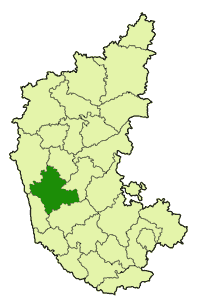
Map of Karnataka with Shimoga district highlighted.
Shimoga district is a part of the Malnad region of Karnataka and is also known as the "Gateway to Malnad" or Malenaada Hebbagilu in Kannada. Located in the central part of Karnataka state, Shimoga district is landlocked, i.e. neither does it have a coastline, nor does it border any other state of India. It is bounded by Haveri District to the northeast, Davanagere District to the east, Chikmagalur District to the southeast, Udupi District to the southwest, and Uttara Kannada to the northwest.
Ranking 9th in terms of the total area among the districts of Karnataka, Shimoga district is spread over an area of 8465 km².[4]
Shimoga lies between the latitudes 13o27' and 14o39' N and between the longitudes 74o38' and 76o04' E at a mean altitude of 640 metres above sea level.[4] The peak of the hill Kodachadri at an altitude of 1343 metres above sea level is the highest point in this district.
The Western Ghats or Sahyadri range and the numerous rivers that originate there provide Shimoga with abundant natural beauty. The numerous lakes, ponds and water bodies make the land very suitable for agriculture. Shimoga is called the rice bowl of Karnataka.
Shimoga district is the origin of the rivers Kali, Gangavathi, Sharavathi and Tadadi. But the two major rivers that flow through this district are Tunga and Bhadra which meet at a place called Koodli near Shimoga city and flow together as Tungabhadra.
Climate[]
Shimoga district being a part of the Malnad(Malenadu) region receives good monsoon rainfall; the months from June to October being the rainy season. In the years 1901-1970, it received an average annual rainfall of 1813.9 mm with an average of 86 days in the year being rainy days.[5]
The average annual temperature of Shimoga District is around 26oC. The average temperature has increased substantially over the years and the trend can be viewed here[6]
In some regions of Shimoga district, the day temperature can really soar to about 40oC during summers, leading to water crisis and other problems.[7]
Geology[]
The major soil forms found in the Shimoga district are Red gravelly clay soil, Red clay soil, Lateritic gravelly clay soil, Lateritic clay soil, Medium deep black soil, Non-saline and saline Alluvo-Colluvial soil and Brown forest soil[8]
Major minerals found in this district are Limestone, White Quartz, Kaolin, Kyanite and Manganese.[9]
Economy[]
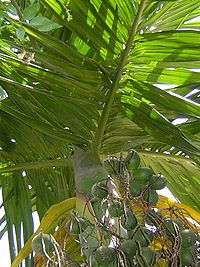
Cornerstone of the Shimoga district's agrarian economy: the arecanut.

Visweswaraya Iron and Steel Limited, Bhadravathi.
Agriculture and animal husbandry are the major contributors to the economy of Shimoga district. Rice, Arecanut, Cotton, Maize and Ragi are the major crops cultivated in this district.[10] Karnataka is the largest producer of arecanut in India, majority of which is cultivated in the Shimoga district. The farmers from Shimoga are said to be very innovative and have managed to cultivate crops like Vanilla and Jatropha previously unheard of in India; yielding high monetary benefits.[11]
Industries[]
Agro-based, Automobile-based and Engineering are the major industries present in Shimoga district.[10] Maximum investment has been made in the Food and Beverages sector followed by Engineering/Mechanical goods sector. To encourage rural industry, rural youth are being imparted training in tailoring, embroidery, motor winding, hand pump repair and other areas. Other rural industries in this district are related to carpentry, blacksmithy, leather, pottery, beekeeping, stone cutting, handlooms, agarbathi (incense sticks) and sandalwood carving.
Karnataka Government has created the following Industrial regions to encourage industrialisation of the district:
- Nidige Industrial Area, Nidige, Bhadravathi Taluk
- Mandli-Kallur Industrial Area, Shimoga
- Shimoga Industrial Estate, Shimoga
- Kallahalli Industrial Estate, Shimoga
Major industries located in Shimoga district are:
- Visvesvaraya Iron and Steel Limited (VISL), Bhadravathi: Started under the able guidance of Sir M Vishweshwaraya, VISL (earlier known as Mysore Iron and Steel plant) has been a pioneer in production of high quality alloy and special steels and pig iron. VISL has an installed capacity of 77,000 tonnes of alloy and special steels and 205,000 tonnes of hot metal. This steel plant now belongs to The Steel Authority of India.
- M/S Mysore Paper Mills Limited (MPM), Bhadravathi: The Mysore Paper Mills Limited is an ISO 14001 Company engaged in the manufacture and marketing of Newsprint, Writing, Printing and Packing Paper of different varieties and Sugar at its plant at Bhadravati, Shimoga District with production capacity of 75000 MTA (Metric Tonne per Annum) of Newsprint, 30000 MTA of Writing, Printing and Packing Paper and 2500 TCD (Tonne Crushings per Day) of Sugar
Shopping[]
Many shops at Shimoga's widely laid boulevards are a Shoppers paradise. The Nehru Avenue [Road], B.H Road, Durgigudi, Balaraj urs Road, Sowlanga Road, Shivappanayaka Market (Now it is demolished and is shifted temporarily to taluk office premises), Gandhi Bazaar are the major commercial centres of Shimoga. Cloth and other related items like dresses, saaris etc., are available at cheaper rates than other places. Most of those, though not of international recognition are of very good quality.and the most famous footwear shop in shimoga is shoe shoppee & shoe garden at BH road
Administrative divisions[]
Shimoga district is divided into 2 Sub-divisions and 7 Taluks. The Sagar Sub-division comprises the taluks of Sagar, Shikaripura, Sorab and Hosanagara while the Shimoga Sub-division comprises the taluks of Shimoga, Bhadravathi and Thirthahalli.
The Shimoga district administration is headed by the Deputy Commissioner who also has the additional role of a District Magistrate. Assistant Commissioners, Tahsildars, Shirastedars (revenue official at Tahsil level), Revenue inspectors and Village Accountants help the Deputy Commissioner in the administration of the district.
Shimoga city is the headquarters of the district. It lies in the south-eastern part of the district. The city is spread over an area of 50 km² and has a population of 274,352, in which 140,224 (51.11%) are males and 134,128 (48.89%) are females. It has a high literacy rate of 83.79%.[12] The city rose into prominence recently when the 73rd All-India Kannada Sahitya Sammelan was held here in the month of December-2006.
Shimoga elects 1 person to the Lok Sabha, the Lower House of the Indian Parliament. The Shimoga Lok Sabha constituency comprises the entire Shimoga district and also covers parts of Nalluru and Ubrani hoblis of Channagiri taluk of Davangere district. As of 2005 it had 1,286,181 voters, of whom Scheduled Castes and Scheduled Tribes account for 2.2 lakhs, Lingayats for two lakhs, Deevaru (Idiga) for 1.8 lakh, Muslims for 1.6 lakh, and Brahmins and Vokkaligas for 1.25 lakh each.[13]
Shimoga also elects 7 people to the Legislative Assembly of the state of Karnataka. The Assembly constituencies in Shimoga district are: Shimoga, Shimoga Rural, Bhadravathi, Sorab, Shikaripura, Thirthahalli, Sagar.
Transport[]
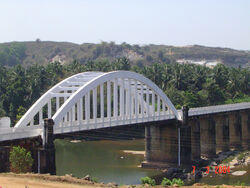
Bridge on the National Highway NH-13 across the river Tunga in Thirthahalli, Shimoga district.
Road[]
Shimoga has a total road length of 6632 km. of which 222 km. belong to the National Highways and 402 km. belong to State Highways.[14]
- National Highways: Shimoga has two National Highways passing through it:
- NH-13 (Sholapur - Mangalore): Starting from the district's border with Davangere, this road passes through the cities of Shimoga and Thirthahalli on to the Chikkamagaluru border.
- NH-206 (Bangalore - Honnavar): Starting from the district's border with Chikkamagaluru, this road passes through the cities of Bhadravathi, Shimoga and Sagar on to the district's border with Uttara Kannada.
- State Highways: Shimoga has eleven State Highways passing through it:
- SH-1 (Padubidri - Maharashtra border): Starting from the district's border with Udupi, this road passes through the towns of Agumbe, Thirthahalli, Shikaripura in Shimoga district on to the district's border with Haveri.
- SH-25 (Bellary - Shimoga): Hospet - Mariammanahalli - Harapanahalli - Harihara - Honnali - Shimoga.
- SH-26 (Halageri - Hulikal) : Starting from the district's border with Haveri, this road passes through the towns of Ayanur, Arasalu and ends at Hulikal which is a town near the district's border with Udupi.
- SH-27: Virajpet - Madikeri - Somavarpete - Sakaleshpura - Mudigere - Vastare - Jayapura - Sringeri - Begar - Agumbe - Byndoor.
- SH-48: (Kumta - Andhra Pradesh border): Starting from the district's border with Uttar Kannada, this road passes through the towns of Sorab and Shikaripura on to the district's border with Davangere.
- SH-50: Bhatkal - Jog - Mavinagundi - Siddapura - Chandragutti - Soraba.
- SH-52: Thirthahalli - Nagara - Balabere - Hosanagadi - Konibasur - Kundapur.
- SH-57: Bagalakote - Badami - Ron - Huyalgola - Gadag - Sirahatti - Guttal - Ranibennur - Masur - Sikaripura - Shimoga - Lakkavalli - Tharikere - Chikamagalur - Belur - Hassan - Holenarasipura - K R Nagar - Belikere - Nanjangud - Yalandur - Beligeriranganabetta.
- SH-65: Malpe - Udupi - Hebri - Agumbe - Begar - Koppa - Narasimharajapura - Sulageri - Bhadravathi - Chennagiri - Shanthisagar - Davanagere - Jagalur - Mustur - B G Kere - Molakalmur.
- SH-62: Haveri - Lingapura - Chikerur - Hirekerur - Siralakoppa- Sagara.
- SH-77: Sirsi - Soraba - Masur - Sagar - haridravathi - Battemallppa - Hosnagar.
Rail[]
The rail network in Shimoga district can be divided among two distinct railway lines that are present in it:
- Birur-Shimoga broad gauge Line: This Broad Gauge (standard gauge used by Indian Railways) line starts from the district's border with Chikkamagaluru and runs through the Bhadravathi station to end at Shimoga station. Numerous trains run from Bangalore and Mysore to Shimoga on this line. Unfortunately, the broad gauge line ends to Shimoga. This is the only Broad Gauge line in this district and serves only the Bhadravathi and Shimoga Taluks. Other Taluks are still to reap the benefits of rail connectivity.
- Shimoga-Talguppa meter gauge Line: This is the older gauge line used by Indian Railways. This line runs from Shimoga Station; passes through the town of Sagar and ends at Talguppa station, just 12 km from the famous Jog Falls. This line was laid by the British in the year 1938, to serve a dual purpose of transporting wooden logs from Malnad forests and also providing access to the falls. Numerous celebrities have travelled on this line to catch a glimpse of the falls. The train that runs now on this track has a heritage associated with it. It consists of only 2 bogies and is in the form of a railbus. It is not a very popular way to reach the falls since it takes around 4 hours to reach Talguppa from Shimoga where as it takes just over an hour to cover the same distance by road. There is a proposal to convert this line into Broad Gauge and finally connect it to the Konkan Railway.[15] Now to Talguppa railway Broad Gauge connection is in process, and that has been done till Anandapuram, from Anandapuram till Talpuppa railway station Broad Gauge connection is in process.
Air[]
Shimoga Airport is under construction in sogane 6 km from Shimoga city. Airports at Bangalore, Mangalore and Hubli can be used for reaching places in the Shimoga district.[16]
Demographics[]
According to the 2011 census Shimoga district has a population of 1,755,512,[17] roughly equal to the nation of The Gambia[18] or the US state of Nebraska.[19] This gives it a ranking of 275th in India (out of a total of 640).[17] The district has a population density of 207 inhabitants per square kilometre (540 /sq mi) .[17] Its population growth rate over the decade 2001-2011 was 6.88 %.[17] Shimoga has a sex ratio of 995 females for every 1000 males,[17] and a literacy rate of 80.5 %.[17]
Taluk has the highest population with Hosanagara Taluk having the least population. The literacy rate in the district is 74.86% (82.32% of males and 67.24% of females are literate). Thirthahalli Taluk has the highest literacy rate (78.27%) while Shikaripura Taluk has the lowest literacy rate (69.59%). The district has a sex-ratio of 977 females to 1000 males. Hosanagara and Thirthahalli Taluks have more females than males and hence have a sex-ratio greater than 1000. Shimoga Taluk having 961 females to 1000 males has the least sex-ratio.[5]
Hindus constitute 85.45% of the population with Muslims making up 12.25% of the population; the remaining part of the population is made up by Christians, Buddhists and other religious groups.[20] Kannada is the dominant language in this district with Urdu taking the second place.
Some of the unique ethnic groups found in Shimoga district are:
- Havyaka Brahmins who speak a unique dialect of Kannada called 'Havigannada'.
- Sanketis who are concentrated near the Mattur-Hosahalli region of Shimoga district and speak a unique language called as Sanketi language.
Culture[]
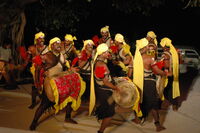
Dollu Kunitha performance at the Fireflies Festival of Sacred Music.

A Yakshagana artist.
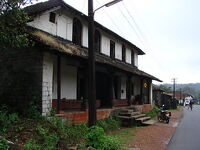
House in Agumbe in which the tele-serial Malgudi Days was shot.
Shimoga district is considered as the heartland of Kannada language and culture. The cultural importance of Shimoga was further highlighted when the All India Kannada Sahitya Sammelana was held here in Dec-2006. This event held by the Kannada Sahitya Parishat was chaired by the famous Kannada poet and writer K S Nisar Ahmed.
Poetry and literature[]
Shimoga has contributed the following highly regarded scholars to the Kannada culture:
- Kuvempu: Kuvempu is the short form of the famous Kannda poet and writer, Kuppalli Venkatappagowda Puttappa; Kuppalli being his native village located in Thirthahalli Taluk. Kuvempu has been conferred the title of Rashtrakavi (National poet laureate) and is also the winner of the Jnanpith award, which is highest literature award of India.
- G S Shivarudrappa: Born in Shikaripura, he is the third person from Karnataka to be conferred the title of Rashtrakavi. Other awards won by him are Soviet Land Nehru Award, Central Sahithya Academy Award and Pampa Award.
- U.R. Ananthamurthy: Born in Melige village in Thirthahalli Taluk, he is also the recipient of the Jnanpith award.
- S V Parameshwara Bhatta: A well known Kannada scholar, he won the Sahitya Academy award in 1990 for his work Kannada Kalidasa Mahasamputa (work on the poems and dramas of Kalidasa)
- M. K. Indira: A well known novelist in Kannada, many of whose novels have been made into films
- Poorna Chandra Tejaswi: son of Kuvempu and a well-known Kannada writer.
- Dr A Murigeppa: Born in Talaguppa village in Sagar Taluk, is a well known linguist and the Vice Chancellor of Kannada University Hampi.
Drama[]
Any description of the culture in Shimoga district would be incomplete without the mention of the cultural organisation called Nilakanteshwara Natya Seva Sangha, better known as NINASAM. Located in a tiny village called Heggodu in Sagar Taluk, NINASAM has made tremendous contribution to the Kannada drama and culture. NINASAM was the result of an experiment by the renowned dramatist, K V Subbanna where he started to screen classical films and hold dramas at Heggodu. Slowly, this became popular and attracted lot of people from all over Karnataka. This popularity prompted the Ford foundation to provide a grant for a rural film and drama project called as Janaspandana, in which similar drama/film festivals and courses were held in other regions of Karnataka. An estimated 200,000 people were exposed to the best of cinema and around 5000 people attended the courses. The Ninasam Theatre Institute started in 1980, offers a 10-month long diploma course in theatre. Another cultural troupe related to NINASAM is Tiruguta (started in 1985 and means moving around in Kannada) where three major productions are taken around Karnataka and shown to the public. For his efforts in promoting Kannada culture, K V Subbanna won the Magsaysay Award[21]
Sculpture[]
Shimoga district is the home of Gudigars. Gudigars are a clan of craftsmen who specialise in carving intricate designs on objects like sandalwood. They are concentrated in the Sagar and Sorab taluks. They make exquisite items by making use of simple tools like knives, screw drivers, drills and saws. The articles made by them are sold at Government emporiums.[22] The most well known sculptor from this clan is Ashok Gudigar who was born in Sagar. Ashok has experimented with various media such as clay, fiberglass, plaster of paris, ivory, red sandstone, granite and soapstone. At the age of 21, he won the Vishwakarma award for his sculpture titled Chalukyan style Ganesha in Shivahonne wood. He also won the National award in the year 1992 at the age of 27 for his work - Hoysala styled Venugopala in Shivahonne wood[23]
Dance[]
Dollu Kunitha and Yakshagana are some of the dance forms which are prevalent in this district
Cinema[]
Majority of the theatres in this district run Kannada movies in certain areas in this district. Cinema Halls : HPC Theatre, Vandana, Mallikarjuan, Veerabhadreshwara, Laxmi, Modern, Manjunatha
Shimoga district rose into limelight, when Agumbe in Thirthahalli Taluk was chosen as the location to shoot the tele-serial Malgudi Days based on a famous novel written by R K Narayan. This serial was directed by the famous Kannada actor and director, Shankar Nag.
Some of the noted cinema personalities born in Shimoga district are:
- Girish Kasaravalli: A well-known film director who has won more Swarna Kamal awards for Kannada classic movies than any other living film director in India, thus enriching Kannnda film industry and Kannada culture in general. He was born in a village called Kesalur in Thirthahalli Taluk.
- P. Lankesh: Born in a village called Konaganahalli in Shimoga district, P Lankesh is famous for being the editor of the controversial tabloid, Lankesh Patrike. He was also a renowned film director who won the national award for the best direction for his very first film Pallavi in the year 1976.
Cuisine[]
Rice is the staple food for majority of the people in Shimoga district. The cuisine in this district is very similar to the Udupi Cuisine.
The cuisine in the Malnad region of Shimoga district includes items like midigayi-uppinakai (tender-mango pickle), sandige (similar to pappadum), avalakki (beaten-rice) and akki rotti. Havyaka people have their own cuisine consisting of such varied items like genesale (sweet made of jaggery, rice and coconut), thotadevvu (sweet made of rice and sugarcane juice) and thambli (a curd preparation containing other ingredients like ginger, turmeric root, jasmine and rose sprouts).
Flora and fauna[]

Lion-tailed Macaque, endemic to the Western Ghats and found in the Malnad region of Shimoga district.

Common Baron butterflies in the Bhadra Wildlife Sanchttp://en.wikipedia.org/w/index.php?title=Shimoga_district&action=edit§ion=22tuary.
As part of the richly forested Malnad region of the Western Ghats, Shimoga district sits in one of the world's biodiversity hotspots with a rich diversity of flora and fauna. The region contains some protected areas classified as wildlife sanctuaries to ensure the protection of these species:
- Gudavi Bird Sanctuary: This is located in Sorab Taluk. Spread over an area of 0.74 km², it comprises a large water tank covering 0.30 ha and a patch of dense moist deciduous forest.[24]
- Flora: Species of flora found here are Vitex leucoxylon, Phyllanthus polyphyllus, Terminalia bellerica, Terminalia paniculata, Terminalia chebula, Lagerstroemia lanceolata, Dalbergia latifolia, Haldina cordifolia, Xylia xylocarpa, Caryota urens, Ficus bengalensis, Ficus religiosa, Butea monosperma, Santalum album, Diospyros melanoxylon, Madhuca longifolia and Kirganelia reticulata.[24]
- Fauna: 191 species have been recorded here, of which 63 are water-dependent. 20 species are known to breed here. Water birds in the sanctuary include the white ibis, darter, little cormorant, Indian shag, cattle egret, little egret, large egret, spoonbill, grey heron, purple heron, pond heron, night heron, coot, pheasant-tailed jacana, purple swamphen, common sandpiper, little ringed plover, little grebe and cotton teal. An average of about 8000 white ibis is known to visit this sanctuary every year.[24]
- Sharavathi Valley Wildlife Sanctuary: This is located in Sagar Taluk. It has evergreen and semi-evergreen forests with its Easter portion adjoining the Linganamakki reservoir.[24]
- Flora: The species found here are Dipterocarpus indicus, Calophyllum tomentosum, Persea macrantha, Caryota urens, Aporosa lindleyana, Calycopteris floribunda, Entada scandens, Acacia concinna, and Gnetum scandens. In the semi-evergreen and moist deciduous forests, common species include Lagerstroemia microcarpa, Hopea parviflora, Dalbergia latifolia, Dillenia pentagyna, Careya arborea, Emblica officinalis, Randia sp., Terminalia sp. and Vitex altissima.[24]
- Fauna: The main animals here are gaurs and groups of lion-tailed macaque. Other mammals include tiger, leopard (black panther), wild dog, jackal, sloth bear, spotted deer, sambar deer, barking deer, mouse deer, wild pig, common langur, bonnet macaque, Malabar giant squirrel, giant flying squirrel, porcupine, otters and pangolins. Reptiles include king cobra, python, rat snake, crocodile and monitor lizard. Avian species found here are three species of hornbill, Asian Paradise-flycatcher, Racket-tailed Drongo, Blue-throated Barbet and lories and lorikeets.[24]
- Shettihalli Wildlife Sanctuary: It lies adjacent to Shimoga town and has forests ranging from dry deciduous to semi-evergreen and is spread over an area of 395.6 km².[24]
- Flora: Trees of the dry deciduous parts include Terminalia tomentosa, Terminalia bellerica, Gmelina arborea, Tectona grandis, Anogeissus latifolia, Lagerstroemia lanceolata, Wrightia tinctoria, Cassia fistula and Emblica officinalis. In the moist deciduous forest, species such as Adina cordifolia, Xylia xylocarpa, Grewia tilaefolia and Kydia Calycina are found. Bamboos, Dendrocalamus strictus and Bambusa arundinacea, are also typical of these forests. The semi-evergreen forests are represented by species of Dipterocarpus, Michelia, Hopea, Schleichera and Bambusa. Plantations of Acacia auriculiformis, Tectona grandis and Grevillea robusta exist in the sanctuary.[24]
- Fauna: Mammals in the sanctuary include tiger, leopard, wild dog, jackal, gaur, elephant, sloth bear, sambar deer, spotted deer, wild pig, common langur, bonnet macaque, common mongoose, striped-necked mongoose, porcupine, Malabar giant squirrel, giant flying squirrel and pangolin. Python, cobra, king cobra, rat snake and marsh crocodile are among the reptiles found in the sanctuary. Birds include hornbills, kingfishers, bulbuls, parakeets, doves, pigeons, kingfishers, babblers, flycatchers, munias, swallows, woodpeckers, peafowl, jungle fowl and partridges.[24] A tiger and lion safari at a place called Tyavarekoppa was created in the north eastern part of the sanctuary in the year 1988.
- Bhadra Wildlife Sanctuary was started in 1951 as Jagara Valley Game Sanctuary covering an area of about 252 km². It was combined with the surrounding Lakkavalli forests in the year 1972 and given its present name of Bhadra Wildlife Sanctuary. It now spans an area of 492 km². It has two component areas Muthodi and Lakkavalli. Some of the wild animals found in this sanctuary are tiger, leopard, wild dog, jackal, elephant, gaur, sloth bear, sambar deer, spotted deer, monitor lizard, barking deer, wild boar, common langur, bonnet macaque, slender loris and the Malabar giant squirrel. Some of the bird species found here are shama, Malabar whistling thrush, various species of bulbuls, woodpeckers, hornbills and pigeons, drongos and Asian paradise flycatcher. The sanctuary has been recently adopted under a tiger-conservation project called 'Project Tiger' which is an initiative from the Indian Government. Best season to visit is from October to February.
- Mandagadde Bird Sanctuary is located on the NH-13 at a distance of 30 km. from Shimoga town on the way to Thirthahalli. This is a small island surrounded by Tunga river and the birds found here are median egret, cormorant, darter and snakebird.
- Tyavarekoppa Lion Safari lies about 10 km. from Shimoga town on the way to Sagar. Lions, tigers and deer are housed here in an enclosed area and a safari is organised.
- Sakrebailu Elephant Camp lies 14 km. from Shimoga town on the way to Thirthahalli. As the name suggests, this is a training camp where elephants undergo training from mahouts.
Education[]
Shimoga district is a major centre for education in the state of Karnataka. A relatively high literacy rate of 74.86% is testimony to the fact. There are various institutions offering education in this district which are briefly detailed in the sections below
Kuvempu University[]
Kuvempu University, near the Bhadra river project is the premier institution catering to the needs of higher education in this district. It is named after the renowned Kannada poet and writer, Kuvempu. Apart from Shimoga district, Kuvempu University has jurisdiction over the districts of Chitradurga and Chikkamagaluru.[25] There are 124 degree colleges affiliated to Kuvempu University; in addition to four Constituent Colleges, administered by the University, and reputed international research centres Centre for the Study of Local Cultures. Graduate and postgraduate teaching programmes exist under the faculties of Arts, Commerce, Education, Engineering, Science and Technology,and Law. Veterinay education:Veterinary college vinobanagr.
Medical education[]
Shimoga Institute of Medical Sciences, a modern medical college, was established in 2007 and located in Shimoga City.
There are two Ayurvedic colleges, one being Bapuji Ayurvedic Medical College located in Shimoga city and the other being T.A.M.E Society's Ayurvedic College located in Kavalgundi, Bhadravathi. Both offer degree courses in B.A.M.S (Bachelor of Ayurvedic Medicine and Surgery).
The dental college, Sharavathi Dental College, is located in Shimoga district.
Graduate education[]
There are 31 colleges in Shimoga district offering graduation courses.[25]
Undergraduate education[]
There are 68 colleges in Shimoga district offering under-graduate (pre-university) education.[25] Notable among these are the DVS PU (Independent) College and DVS PU Composite college whose alumni have bagged many ranks in the Pre-University and Engineering Entrance Examination[26][27]
Primary and secondary education[]
There are 1147 schools offering Primary Education and 313 High-Schools offering Secondary Education in the Shimoga district.[25] Many primary and secondary schools hav provided excellent results and the district ranks in the top 10 of Karnataka. Recently a few notable CBSE affiliated private schools of high calibre have opened too. Jawahar Navodaya and Morarji Desai Schools are located near Shimoga at Gajanur. One of the notable private school is Jnanadeepa School located at Javalli near Shimoga started by the eminent educationalist and former DVS principal V Devendra.
Sports[]
Some of the common sports being played by the people in Shimoga district include cricket, football, badminton, volleyball and handball. The major national sports event held in this district was the 18th Junior National Athletic Championship which was held in Shimoga in the year 2003.
Arguably, cricket is the most favourite sport in this district as it is with the rest of India. Shimoga district has offered one of the best batsmen ever to play Indian cricket, Gundappa Viswanath who was born in Bhadravathi. Even roads turn into cricket pitches where the boys play their own version of the cricket with own set of rules, commonly called as galli cricket. No international cricket matches have ever been staged in Shimoga district; though the district has played host to Ranji Trophy matches, which is the premier national level cricket tournament in India. The following stadiums here have hosted Ranji Trophy matches:
- sagar, stadium, sagar-577401
- Nehru Stadium, Shimoga
- VISL Cricket Stadium, Bhadravathi
- Indoor stadium for handballhandball, basketball, volleyball in shimoga
Some unique outdoor games like kho kho, kabaddi, Chinni Daandu, 'goli'(marbles), 'kunte bille' and 'lagori' find more favour in the rural areas of the district. Board games like carrom, chess and channe mane are also played here. Sports:
Shimoga presents a robust profile on the sports front with a good infrastructure, a good number of record holders and a great deal of players and enthusiasts. The youth of the district play all major sports—football, cricket, hockey,handball,basketball, table tennis, volleyball and badminton. Sportspersons from the district have represented Karnataka in athletics, basketballs, kho-kho, volleyball, kabaddi, badminton and wrestling and won National and International acclaim (at Asian and Commonwealth Games), particularly in power-lifting, bodybuilding and wrestling.
Shimoga has a nodal point for training in wrestling and related sports, with veteran wrestling-trainers and well-equipped gymnasia. Kho-kho is also a major sports in which the district has consistently excelled, created several records in Dasara Sports. In the recent days, however, cricket has been all over the sports scenario of the district— a part of the national phenomenon—with league-level coaching facilities springing up in many places. There has also been growth of cricket clubs in the district which has, at times, tended to attract even political attention by the sheer virtue of their 'captive' youth power. Badminton has also received due priority here with a facility that is among the best in the state. Shimoga is famous for its motorbike and car rallies which whip up heavy popular excitements in and around the district. Treasure-hunt rallies are conducted regularly, which attract huge number of youth participants. Along with all other sports Shimoga is emerging as a centre for adventure sports, with lots of youth showing interest in trekking (in which district has an unbeatable natural advantage) and other such sports. These days treasure hunt has become a rage here, drawing hundreds of youth into its fold.
The town sports a well-equipped stadium—the Nehru Stadium—with exclusive facilities for different sports, including a table tennis hall and gymnasium. Sports events such as all-India cross-country relay race from Chikkamagalur to Shimoga, all-India invitation kho-kho tournament, state-level volleyball championships and football tournaments have all been hosted at Shimoga. Every town in the district has one or more recreation clubs with facilities for indoor and outdoor games.
Antiquities[]
Legends compare 12th century Balligavi in Shikaripura taluk to Lord Indra's Amaravathi or Lord Kubera's Alakavathi. Balligave was the centre of learning, secular arts, commerce and sculpture. The town had thirteen education centers, fifty four temples of which only a few survive today, twelve Jain basadis, three Buddhist viharas and many majestic palaces, lakes, wide roads and a population of about sixty thousand. Archaeological evidence points to existence of Balligavi as early as the Shatavahanas. Balligavi was the center of many religions like Shaiva and Vaishnava Hinduism, Brahmi, Shaktha, Jainism, Buddhism.
The Kedareshwar temple (1060 C.E.) in Chalukya-Hoysala style, Tripurantkeswar temple (1070 C.E.), Gandabherundeswar temple (1070 C.E.) in later Chalukya style in Balligavi and the Aghoreshwara temple at Ikkeri and the Rameshwara temple at Keladi both built in the 17th. century by the Keladi Nayakas are silent reminders of a glorious past. The Nayakas have used a variety of styles from predecessor kingdoms like the late Kadambas, Hoysala and even dravida styles. Balligavi was also the native place of Shantaladevi, queen of Hoysala Vishnuvardhana. Many sculptors who worked for the Hoysalas to build the famous temples at Belur and Halebid came from here including Dasoja, Malloja, Nadoja, Siddoja. During the Virashaiva movement, Balligavi contributed great Vachanakaras like Allama Prabhu who was born here and other like Akka Mahadevi, Animishayya and Mukthayakka who were also associated with this place.
Tourist attractions[]
Water falls[]
- Jog Falls: This is the 11th highest waterfall in India and ranks 313 in the list of highest waterfalls in the world.[28] With a total height of 253 mts; this is where the river Sharavathi falls into a deep gorge in four distinct flows of water which are termed as Raja, Rani, Rover and Rocket. Jog Falls lies in Sagar Taluk and is 30 km. from the town of Sagar.
- Kunchikal Falls: Having a height of 455 mts, Kunchikal Falls is the highest waterfall in India and ranks 116 in the list of highest waterfalls in the world.[28] This waterfall is located near Agumbe and is formed by the Varahi River. The hydropower is used for the production of electricity.
- Barkana Falls: Located near Agumbe and 80 km. from Thirthahalli town, Barkana Falls is the 10th highest waterfall in India and ranks 308 in the list of highest waterfalls in the world.[28]
- Achakanya Falls: This is near a place called Aralsuruli, 10 km from the town of Thirthahalli on the way to Hosanagara. This is also formed by the Sharavathi river.
- Vanake-Abbey Falls: In the heart of Malnad forests, this waterfall is located 4 km. from Agumbe.
- Hidlamane Falls: A significant amount of trekking takes one to these falls located near Nittur in Hosanagara Taluk.
- Dabbe Falls: This waterfall is located near a place called Hosagadde in Sagar taluk. On the road from Sagar to Bhatkal, Hosagadde lies at a distance of about 20 km from the town of Kargal. From Hosagadde a walk of 6–8 km into the forest, leads one to Dabbe Falls.
Dams[]
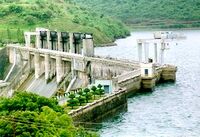
Bhadra River Project Dam in Bhadravathi Taluk.
- Linganamakki dam: This dam is built across the Sharavathi river and is located 6 km. from the Jog Falls. It is also the location of the Mahatma Gandhi Hydro-electric project which has a power generating capacity of 55 MW. Water which is released from this dam flows into the Jog Falls. The best sight of the Jog Falls is in the monsoon season when excess water is released from this dam.
- Bhadra River dam: This dam lies across Bhadra River at Lakkavalli, a distance of 20 km from Bhadravathi City. The whole design of this dam was done by Sir. M. Vishweshwaraiah, the then Chief Engineer of Karnataka State. The dam mainly serves the purpose of irrigation in and around Bhadravathi Taluk and Tarikere Taluk of Chikkamagaluru district.
- Gajanur dam: This dam is built across the river Tunga in a village called Gajanur, 12 km from Shimoga city on the National Highway NH-13 (the road that goes to Thirthahalli).n n m
River sources and confluences[]
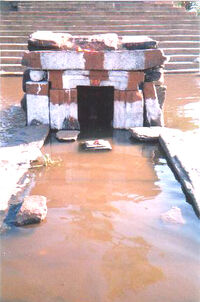
A small temple and water tank at Koodli, where the Tunga and Bhadra rivers meet to form Tungabhadra.
- Koodli: Located 16 km. from the Shimoga city, Koodli is the place where the two rivers, Tunga and Bhadra join and become Tungabhadra river, one of the largest tributaries of the river Krishna. Koodli also contains two temples of the Hoysala era, one dedicated to the Hindu God, Rameshwara and the other to Narasimha. An inscription in the temple indicates that in the year 1313, the Hoysala king, Veera Ballala III provided grants to the temple. Koodli also contains a religious institution called Koodli Matth, which propagates philosophy of Shankara.
- Ambuteertha: Located 10 km. from Thirthahalli on the Thirthahalli-Hosanagara road, Ambuteertha is the source of the river Sharavathi. Starting from here, Sharavathi travels westwards to reach the Arabian Sea near Honnavar, 132 km. away.
- Varadamoola: Located 6 km. from Sagar town, Varadamoola is the source of the river Varada. Varada flows through the town of Banavasi before joining Tungabhadra.
Hill stations and beyond[]
- Agumbe west of Shimoga city is at a distance of 90 km. The altitude here is 826 meters, and the place is famous for its enchanting Sunsets. As the Sun sets, it takes on different colours and this is reflected by the Arabian sea.
- Kavaledurga is a magnificent fort located on a hill at an altitude of 5,056 feet (1,541 m).
- Kodachadri Hills is 115 km. from Shimoga city. At an altitude of 1,411 ft (430 m) This hill station provides great views of the forests of the western ghats in Shimoga and Dakshina Kannada districts. This good weekend getaway is only now being discovered by those other than hardy trekkers.
- Kundadri has unique rock formations and has good views
- Chibbalagudde, Thirthahalli, very calm, nice place which is in bank of Tunga river, Siddivinayaka temple.
another tributary of sharavathi called kari hole originate from near talaneri which is the place near hosanagara
History and religion[]
- Shimoga fort is mostly in ruins but a well renovated Hoysala temple of Seetharamanjaneya is worth visiting. Its one of the oldest hanuman temple in the world.
- Shivappa Nayaka Palace and Museum is located right in the city of Shimoga itself. The palace built by the 17th. century ruler Shivappa Nayaka contains many interesting pieces of sculpture and artifacts from that period.
- Government Museum in the city contains many ancient coins, manuscripts and inscriptions for the historically inclined.
- Bhadravathi town is called "steel town" for its steel industries. The Lakshminarasimha temple of 13th. century Hoysala style is worth a visit.
- Chandragutti in Soraba taluk is a short distance from Balligavi. The fort built by Banavasi Kadambas and the Renukamba temple are the places to see.
- Humcha is a Jain pilgrimage place with 10th and 11th century Panchakuta basadi, Padmavathi temple and Jain Math which are worth visiting.
- Church of the Sacred Heart is in the city itself and is the second largest in India
- Kubetoor has several Kalyani Chalukyan temples. The Kedareshvara temple is the best.
- Nagara was the last capital of the Keladi Kings. The Hyder Ali tank, Neelakanteshwara and Venkataramana temple are of interest here.
- Sagara and Soraba are famous for their wood carvings and handicrafts. They have a long history of the art.
- Talagunda is an important place in terms of archaeology. This place has several ancient temples and has unveiled very important inscriptions including the famous 450 C.E. "Talagunda inscription" of Shantivarman, an early Kadamba king. The inscription is in Prakrit language and has given historians very useful information about the Kadamba Kingdom and its history.
- Uduthadi, birth place of Virashaiva saints Akka Mahadevi and Vaitagyanidhi.
Wildlife[]
- See Flora and fauna section above
Gallery[]
Notes[]
- ^ "Shimoga:Census2011". census2011.co.in. http://www.census2011.co.in/census/district/266-shimoga.html.
- ^ "Who's Who". National informatics centre. http://shimoga.nic.in/admin.htm.
- ^ a b The etymology and history of Shimoga is discussed in the webpage developed by National Informatics Centre. "History of Shivamogga". The Official website of Shimoga District. District Administration, Shimoga. http://shimoga.nic.in/history.htm. Retrieved 2007-03-25.
- ^ a b The Geography of Shimoga district is described in a webpage designed by National Informatics Centre. "Geography of Shivamogga". The Official website of Shimoga District. District Administration, Shimoga. http://shimoga.nic.in/geogry.htm. Retrieved 2007-03-25.
- ^ a b Statistics related to Shimoga district is described in a webpage designed by National Informatics Centre. "Statistics of Shimoga district". The Official website of Shimoga District. District Administration, Shimoga. http://shimoga.nic.in/stats.htm. Retrieved 2007-03-25.
- ^ Temperature Trend
- ^ Soaring temperatures in Shimoga causing problems, as reported by Special Correspondent (2005-04-08). "Tinder-box in Malnad". The Online Edition of the Hindu - ePaper, 2005-04-08, (Chennai, India: 2005, The Hindu). http://www.hindu.com/2005/04/08/stories/2005040802040300.htm. Retrieved 2007-03-25.
- ^ Soil distribution in Karnataka state is discussed in a webpage by National Informatics Centre. "Traditional Soil Groups of Karnataka and their Geographic Distribution". Official Website of the Department of Agriculture, Govt. of Karnataka. Govt. of Karnataka. http://raitamitra.kar.nic.in/agriprofile/table5.htm. Retrieved 2007-03-25.
- ^ Minerals found in Shimoga district are mentioned by the National Informatics Centre. "Industrial Scenario". Official Website of the Shimoga District. District Administration, Shimoga. http://shimoga.nic.in/indus.htm. Retrieved 2007-03-25.
- ^ a b Economy of Shimoga district is discussed by National Informatics Centre. "Industrial Scenario". Official Website of the Shimoga District. District Administration, Shimoga. http://shimoga.nic.in/indus.htm. Retrieved 2007-03-25.
- ^ Vanilla and Jathropa cultivation in Shimoga district, as discussed by Deccan Herald News Service. "Jathropa catches attention of farmers in Shimoga". Online edition of the Deccan Herald, 2004-09-09. 2004, The Printers (Mysore) Private Ltd. http://www.deccanherald.com/deccanherald/sep092004/d15.asp. Retrieved 2007-03-25.
- ^ The population and area of Shimoga city has been mentioned in the webpage Population of Corporation/CMC/TMC/TP belonging to the Municipal Administration Department of the Government of Karnataka
- ^ Details regarding the Shimoga Lok Sabha constituency is mentioned by Pramod Mellegatti (2005-06-01). "Aggressive campaigning by all parties for Shimoga byelection". Online Edition of The Hindu, 2001-06-01 (Chennai, India: The Hindu). http://www.hindu.com/2005/06/01/stories/2005060105490400.htm. Retrieved 2007-03-25.
- ^ Transport related statistics are mentioned by National Informatics Centre. "Statistics on Shimoga". Official Website of the Shimoga District. District Administration, Shimoga. http://shimoga.nic.in/stats.htm. Retrieved 2007-03-25.
- ^ Heritage associated with the Talguppa Line is discussed by Times News Network (2003-12-07). "Heritage train turns bone of contention". ShivamoggaOnline Edition, Times of India, 2003-12-07 (2007, Times Internet Limited). http://timesofindia.indiatimes.com/articleshow/344143.cms. Retrieved 2007-03-25.
- ^ Proposal to construct an airport in Shimoga city is reported by Special Correspondent (2006-04-08). "Airport at Shimoga likely to come up at Sogane". The Online Edition of the Hindu - ePaper, 2006-04-08, (Chennai, India: 2006, The Hindu). http://www.hindu.com/2006/04/08/stories/2006040810350300.htm. Retrieved 2007-03-25.
- ^ a b c d e f "District Census 2011". Census2011.co.in. 2011. http://www.census2011.co.in/district.php. Retrieved 2011-09-30.
- ^ US Directorate of Intelligence. "Country Comparison:Population". https://www.cia.gov/library/publications/the-world-factbook/rankorder/2119rank.html. Retrieved 2011-10-01. "Gambia, The 1,797,860 July 2011 est."
- ^ "2010 Resident Population Data". U. S. Census Bureau. http://2010.census.gov/2010census/data/apportionment-pop-text.php. Retrieved 2011-09-30. "Nebraska 1,826,341"
- ^ Data related to the 2001 Census; classified according to religion is provided in detail in the website of the Census department of India in this webpage
- ^ An article on NINASAM presented by Chaman Ahuja. "Committed to culture and creativity". Online Edition of The Tribune - Issue Feb 14, 1999. 2006, The Tribune Trust. http://www.tribuneindia.com/1999/99feb14/sunday/head2.htm.. Retrieved 2007-03-25.
- ^ Description of Gudigars is given in this webpage: The Gudigars of Kanara
- ^ An article on Ashok Gudigar has been presented by Shubha Shrikanth. "Poetry in stone". Webpage of OnlineBangalore.com. OnlineBangalore.com. http://www.onlinebangalore.com/pers/ashoka.html.
- ^ a b c d e f g h i Flora and Fauna present in the wildlife sanctuaries of Karnataka are mentioned in the webpage: "SANCTUARIES &NATIONAL PARKS OF KARNATAKA". Centre for Ecological Sciences, Indian Institute of Science. http://ces.iisc.ernet.in/biodiversity/documents/sanpeack.htm. Retrieved 2007-05-10.
- ^ a b c d Education details in Shimoga district is discussed by National Informatics Centre. "Educational Scenario". Official Website of the Shimoga District. District Administration, Shimoga. http://shimoga.nic.in/educat.htm. Retrieved 2007-03-26.
- ^ Ranks bagged by Under-graduate colleges in Shimoga are mentioned by Deccan Herald News Service. "CET ranks announced". Online Edition of the Deccan Herald, dated 2004-06-11. 2004, The Printers (Mysore) Private Ltd.. Archived from the original on 2007-02-28. http://web.archive.org/web/20070228154716/http://www.deccanherald.com/deccanherald/Jun112004/i2.asp. Retrieved 2007-03-26.
- ^ Ranks bagged by Under-graduate colleges in Shimoga are mentioned by Staff Reporter (2006-06-04). "CET: 99,308 ranks assigned, only 4,557 seats on offer". Online Edition of The Hindu, dated 2006-06-04 (Chennai, India: 2006, The Hindu). http://www.hindu.com/2006/06/04/stories/2006060419280100.htm. Retrieved 2007-03-26.
- ^ a b c The list of the highest waterfalls in the India is present in the webpage: Highest Waterfalls in India
External links[]
- Census
- Shivamogga Zilla Panchayat
- Shivamogga distrcit Official Website
- Western Ghats
- Map of Shivamogga District
- Shivamogga results

|
Uttara Kannada district | Haveri district | 
| |
| Davanagere district | ||||
 Shimoga district | ||||
| Udupi district | Chikmagalur district |
| ||||||||||||||||||||||||||||||||||||||||||||||||||
| This page uses content from the English language Wikipedia. The original content was at Shimoga district. The list of authors can be seen in the page history. As with this Familypedia wiki, the content of Wikipedia is available under the Creative Commons License. |

